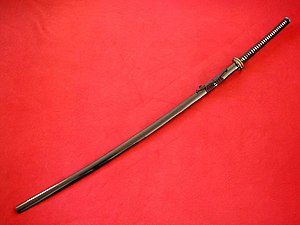Ōdachi
| Ōdachi | |
|---|---|

|
|
| Information | |
| Weapon type: | sword |
| Designations: | Nodachi |
| Use: | Weapon, traditional weapon |
| Creation time: | around 15th century |
| Working time: | until now |
| Region of origin / author: |
Japan , samurai |
| Distribution: | Japan, today worldwide |
| Handle: | Wood, metal, ivory , fish skin, silk |
| Particularities: | Since the Ōdachi was quite unwieldy, its combative use was mostly limited to open field battles. |
| Lists on the subject | |
The Ōdachi ( Japanese 大 太 刀 , "large tachi") or also nodachi ( 野 太 刀 , "field tachi") is a longer variant of the Japanese sword known as tachi .
description
The Odachi was wound or because of its length over the back in his hand. There are also historical illustrations in which a servant carries his master's weapon. The fact that most of the historically preserved weapons were used as a ceremonial weapon or ceremonial sword often leads to the assumption that this was the only purpose. Rather, in the course of Japanese history there was a law that limited the length of the blade, which is why most of the non-ceremonial blades were shortened. Since the Ōdachi was quite unwieldy, its combative use was mostly limited to open field battles. Ōdachi were forged just like ordinary Nihontō . This explains the high cost of manufacturing this weapon, as it was also partially hardened and classically polished.
Special versions
The longest known Ōdachi has a total length of 377 cm. It was made by the Japanese master swordsmith Norimitsu from Osafune in the former Bishū in August 1446. It is now kept in the Kibitsu Shrine in Okayama . The special thing about the sword is that the blade is forged from one piece, in the same way as a conventional Japanese sword ( katana ). Other temple swords of special lengths were assembled from two parts. The blade is hardened differently, the hamon is real and the blade has a bo-hi (fuller or colloquially, but inappropriately "blood groove").
Description of the special form
- Total length: 377 cm
- Nagasa (edge): 226.7 cm
- Sori (curvature): 5.0 cm
- Nakago (Angel): 151 cm
- Blade thickness (maximum): 2.34 cm
- Habaki : 5.85 cm
- Weight: 14.5 kg
- Mei (blade signature): Bishū Osafune Norimitsu ( 備 州長 船 法 光 )
- Place of storage: Kibitsu Shrine
- Production time: August 1446
- Sugata (blade shape): Shinogi-zukuri , maru-mune, bo-hi with maru-dome
- Hada (blade grain): Itame
- Hamon (shape of the hardness line): Ko-gunome, choji with tobiyaki and kinsuji.
literature
- Nick Evangelista : The encyclopedia of the sword. Greenwood Publishing Group, 1995, page 419, ISBN 978-0-313-27896-9 .
- Stephen Turnbull: The Samurai Swordsman: Master of War. Tuttle Publishing, 2008, ISBN 978-4-8053-0956-8 .
Web links
- A gallery with some Odachi
- Webpage with images of the Norimitsu Ōdachi
- Size comparison. Swordmaster Hayashi Kunishiro with his Ōdachi